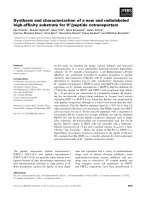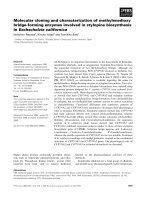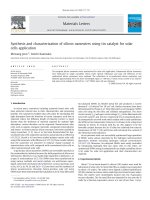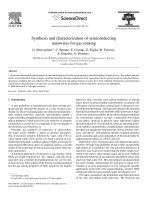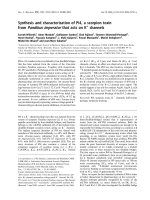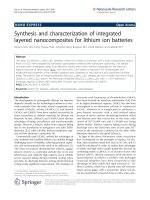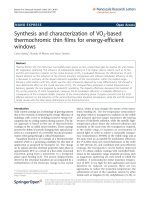Synthesis and characterization of collagen terpolymer fibers for applications in tissue engineering
Bạn đang xem bản rút gọn của tài liệu. Xem và tải ngay bản đầy đủ của tài liệu tại đây (10.09 MB, 169 trang )
SYNTHESIS AND CHARACTERIZATION OF COLLAGEN-
TERPOLYMER FIBERS FOR APPLICATIONS IN TISSUE
ENGINEERING
YOW SOH ZEOM
(BSc (Hons), NUS; MSc, University of Liverpool)
A THESIS SUBMITTED FOR THE DEGREE OF DOCTOR OF PHILOSOPHY
GRADUATE PROGRAMME IN BIOENGINEERING, SCHOOL OF MEDICINE
NATIONAL UNIVERSITY OF SINGAPORE
2009
Dedicated to the memory of my grandmother;
for her love and for the life values she instilled in me
and who was the biggest influence in my life.
i
Acknowledgments
I wish to express my gratitude to Professor Kam W Leong for his guidance, support
and encouragement, for the wonderful scientific interactions which I have benefitted
greatly; Associate Professor Lim Chwee Teck for his guidance, support and for
providing a supportive and conducive laboratory environment which I am grateful for
and Assistant Professor Evelyn Yim for her guidance, mentorship and willingness to
share her knowledge and expertise.
I am thankful to Ms Quek Chai Hoon for her guidance in polymer synthesis and Mrs
Ooi from NUS control lab for the loan of a function generator for electrical stimulation
studies.
Mr Lim Tze Han for his guidance in polymer synthesis and for being a great scientist
and teammate to work with and special thanks to the staff of Highlander’s Coffee cafe
for the wonderful coffee and great environment for us to brainstorm our ideas and
work.
Everyone in NUS Nanobiomechanics Laboratory and NUS Regenerative Medicine
Laboratory for their help, great companionship and for being part of a wonderful lab
environment where I have enjoyed working in and sharing science with.
My best buddies and wonderful friends for their unyielding support, love and comfort
food.
My family for their love and support; for the values they instilled in me, the many
rides they gave so I could spend less time on the road, of course, more comfort food
and Ben for his companionship and love and whom I have to share my comfort food
with.
ii
Table of Contents
Acknowledgments i
Table of Contents ii
Summary v
List of Tables vii
List of Figures viii
Chapter 1: Introduction 1
Chapter 2: Literature Review 6
2.1 Introduction of Tissue Engineering 6
2.2 Biomaterials for Tissue Engineering 7
2.2.1 Requirements and Classification of Biomaterials 7
2.3 Scaffold Fabrication Techniques: A Review 13
2.3.1 Conventional Scaffold Fabrication Techniques 13
2.3.2 Electrospinning 14
2.3.3 Interfacial Polyelectrolyte Complexation (IPC) 15
2.4 Biofunctionalisation of Biomaterials 19
2.5 Cell Infiltration and Spatial Distribution of Cells in Scaffolds 22
2.6 Cell Encapsulation in Gels and Cell Sheet Engineering 23
2.7 Cell Encapsulation by Interfacial Polyelectrolyte Complexation 24
2.8 Conducting Polymers for Tissue Engineering 28
Chapter 3: Materials Synthesis and Polyelectrolyte Complex (PEC) Fiber
Fabrication 35
3.1 Materials 35
3.2 Synthesis of MMA-HEMA-MAA Terpolymer 35
3.2.1 Molecular weight determination of MMA-HEMA-MAA Terpolymer 36
3.3 Collagen Methylation 36
3.4 Terpolymer-Collagen PEC Fiber Formation 37
3.5 Polypyrrole-incoporated Polyelectrolyte Complex Fibers 37
3.6 Results and Discussion 38
3.6.1 PEC Fibers 38
3.6.2 Mechanism of PEC Fiber Formation 42
3.6.3 Polypyrrole Incorporation into PEC Fibers 44
3.7 Design of Device for PEC Fiber Fabrication 47
iii
3.7.1 Determination of a Suitable Material for the Flow Channel of Polyelectrolytes 48
3.7.2 Device Setup 49
3.7.3 Effects of Flow Rates and Drawing Rates 50
3.7.4 Discussion 54
Chapter 4: Characterization of Polyelectrolyte Complex (PEC) Fibers and
Polypyrrole incorporated PEC fibers 55
4.1 Mechanical property measurement of PEC fibers 55
4.1.1 Results 56
4.2 AFM imaging 59
4.2.1 PEC Fiber Diameter Measurement 60
4.2.2 PEC Fiber Surface Topography and AFM Phase Imaging 61
4.2.3 AFM imaging of Wet PEC Fibers 62
4.2.4 AFM imaging of polypyrrole PEC fibers 63
4.3 Quantum dot labelling of collagen 67
4.3.1 Distribution of Collagen in Fibers 69
4.4 Fiber Swelling Studies 70
4.5 Discussion 71
Chapter 5: Seeding and Encapsulation of Human Mesenchymal Stem Cells in
PEC Fibers 75
5.1 Introduction 75
5.2 hMSC Culture and Expansion of Cell Lines 76
5.3 hMSCs Seeding on PEC Fibers 76
5.4 hMSC Encapsulation in PEC Fibers 76
5.4.1 Cell Concentration Effects 77
5.5 Cell Viability and Proliferation Studies 79
5.6 Cytoskeletal Staining of Seeded and Encapsulated hMSCs 81
5.7 Reverse Transcriptase PCR Studies of hMSCs 84
5.8 Discussion 87
5.8.1 hMSCs-encap and hMSCs-seed Behaviour and Interaction with PEC Fibers 87
5.8.2 mRNA Expressions 88
Chapter 6: hMSC and C2C12 Cell Culture on Polypyrrole-incorporated PEC
Fibers in an Electrically Stimulated Environment 92
6.1 Introduction 92
6.2 Electrical Stimulation Setup 92
iv
6.3 Fiber Preparation 94
6.4 Cell culture 95
6.5 Proliferation Assay 96
6.6 Immunostaining of Differentiation Markers and Proteins 99
6.6.1 Expression of Neuronal Markers in hMSCs 99
6.6.2 Expression of Skeletal and Cardiac Markers in C2C12 Cells 107
6.7 Reverse Transcriptase-PCR studies of hMSCs seeded on PPyr-PEC and PEC Fibers.118
6.8 Discussion 120
Chapter 7: Conclusions and Recommendations for Future Work 127
7.1 Conclusions 127
7.2 Recommendations for Future Work 128
7.2.1 Design of Device for PEC Fiber Fabrication 128
7.2.2 Electrical Stimulation of Cells Seeded on Electroactive PEC Fibers 129
7.2.3 Co-culture Studies with Haematopoietic Stem Cells (HSCs) 129
7.2.4 Encapsulation of Neuronal Cells in PEC Fibers 130
References 131
Appendix A: Molecular Weight Determination of Terpolymer by GPC 141
Appendix B.1: Primers used for RT-PCR studies 142
Appendix B.2 : Design of RT-PCR primers 144
Appendix B.3: Purification of RNA for Gene Analysis Studies 146
Appendix B.4: Reverse-Transcriptase Polymeric Chain Reaction (RT-PCR) 151
Appendix C: PhD Research Output 155
v
Summary
Living tissues consist of groups of cells organized in a controlled manner to perform a
specific function. Spatial distribution and organization of cells within a three-
dimensional matrix is critical for the success of any tissue engineering construct.
Fibers endowed with cell-encapsulation capability would facilitate the achievement of
this objective. Here we report the synthesis of a cell-encapsulated fibrous scaffold by
interfacial polyelectrolyte complexation (IPC) of methylated collagen and a synthetic
terpolymer (methacrylic acid, hydroxyethyl methacrylate and methyl methacrylate).
Both natural and synthetic polymers were chosen with the intention of synergising the
merits of both polymer types to produce fibers with the desired complementary
properties. The collagen component was found to be well distributed in the
polyelectrolyte complex (PEC) fibers, which had a mean ultimate tensile strength of
244.6 ± 43.0 MPa.
The ambient operating conditions of this IPC technique permit the encapsulation of
human mesenchymal stem cells (hMSCs) within the PEC fibers and they have
remained viable. Cultured in proliferating medium, human mesenchymal stem cells
(hMSCs) encapsulated in the fibers showed higher proliferation rate than those seeded
on the scaffold. Gene expression analysis revealed the maintenance of multipotency
for both encapsulated and seeded samples up to 7 days as evidenced by Sox 9, CBFA-
1, AFP, PPARγ2, nestin, GFAP, collagen I, osteopontin and osteonectin genes.
Beyond that, seeded hMSCs started to express neuronal-specific genes such as
aggrecan and MAP2.
Polypyrrole polymer was incorporated into the PEC fibers to produce a collagen-based
electroactive fiber system. hMSCs and mouse skeletal cells C2C12 were cultured on
vi
these fibers under an electrical stimulation. Both cell lines showed increased
proliferation over a period of 5 days. Immunofluorescent staining of hMSCs showed
an upregulation of synaptophysin, indicating the establishment of synapse and
electrical communication between cells. Upregulation of connexin 43 and myosin
heavy chain proteins and Troponin I and F-actin striations were observed in C2C12
cells. The studies suggest that the electroactive PEC fibers could support the neuronal
and skeletal differentiation of hMSC and C2C12 respectively.
In conclusion, the study demonstrates the appeal of IPC for scaffold design in general
and the promise of collagen-based and electroactive collagen-based hybrid fibers for
tissue engineering in particular. It lays the foundation for building fibrous scaffold that
permits 3D spatial cellular organization and multi-cellular tissue development.
vii
List of Tables
Table 2.1: Conventional scaffold processing techniques for tissue engineering [25] 13
Table 2.2: Conductivity of conducting polymers [48] 30
Table 6.1: Primers used for mRNA expression studies of hMSCs cultured on PPyr-
PEC and PEC fibers in an electrically stimulated environment. 118
Table A: RT-PCR Master Mix 152
Table B: Calculation of hMSCs RNA concentrations 153
Table C: Thermal cycler conditions 154
viii
List of Figures
Figure A: RNA isolation flow chart (taken from Qiagen 1 step RT-PCR handbook)
148
Figure 1.1: Tissue engineering paradigm 2
Figure 2.1: Schematic diagram of interfacial polyelectrolyte complexation of
oppositely charged polyelectrolytes and formation of the insoluble fiber from the
interface. 17
Figure 2.2: Hypothesized fiber formation mechanism by interfacial polyelectrolyte
complexation [31]; (a) formation of a viscous barrier, (b) formation of multiple
nucleation sites, (c) growth of nucleation sites and (d) coalescence of nucleation sites.
17
Figure 2.3: Schematic of cell encapsulation process in PEC fibers. 25
Figure 2.4: Chemical structures of (a) MMA-MAA-HEMA terpolymer [29] and (b)
methylated collagen [36]. 27
Figure 2.5: Introduction of polaron and bipolaron lattic deformation upon oxidation (p-
type doping) in heterocyclic polymers. X = S, N, or O. [48] 29
Figure 3.1: Schematic diagram of terpolymer-collagen fiber formation. 37
Figure 3.2: Chemical reaction scheme of MMA-HEMA-MAA [29] 39
Figure 3.3: GPC molecular weight determination of MMA-HEMA-MAA terpolymer.
41
Figure 3.4: Chemical structure of methylated collagen. 42
Figure 3.5: Terpolymer-collagen PEC fibers formed by IPC. (A) Schematic diagram
showing the drawing of fiber from the polyelectrolytes interface. (B) Spun fibers
collected and dried on the motorized roller. The dried fiber meshes are indicated by the
white arrow. (C) Bright field image of PEC fiber bead submersed in 1xPBS. (D) SEM
micrograph of the dried fibers. 43
Figure 3.6: Schematic diagram showing the expulsion of hydrophobic species such as
pyrrole monomers from IPC fiber drawing interface. 46
Figure 3.7: (A) Formation of 2-Hydroxypropyl-β-cyclodextrin-pyrrole inclusion
complex for the incorporation of pyrrole into PEC fibers. (B) Chemical polymerization
of pyrrole by FeCl
3
. 47
ix
Figure 3.8: Plot of contact angle measurements of various materials, n=10. 49
Figure 3.9: PEC fiber drawing device setup and schematic diagram of the
polyelectrolyte interface area. 50
Figure 3.10: (A) Length of fiber drawn versus polyelectrolytes flow rates using
5mg/mL methylated collagen. (B) Length of fiber drawn versus polyelectrolytes flow
rates using 3mg/mL collagen. 52
Figure 4.1: Schematic diagram showing mounting of fiber specimen on cardboard
frame. 56
Figure 4.2: Stress-strain graphs of Collagen 5mg/mL-Terpolymer 0.55wt% (denoted
by Collagen 5mg/mL in legend), Collagen 3mg/mL-Terpolymer 0.55wt% (Collagen
3mg/mL) and Polypyrrole-Collagen 5mg/mL-Terpolymer 0.55wt% (Pyr + Collagen
5mg/mL) 57
Figure 4.3: AFM height and amplitude images and section analysis of the main fiber
(A)-(C) and bead region (D)-(F) respectively. (A)-(B) are 30 µm scans and scale bar =
7.5 µm. (D)-(E) are 68.6 µm scans and scale bar = 17 µm. 61
Figure 4.4: (A-C) 4µm and (D-F) 1.57µm AFM height, amplitude and phase images of
collagen-terpolymer fiber, respectively. The AFM height scale bars are presented at the
extreme left. The height (A,D) and amplitude images (B,E) show the topographical
details of the fibrils of the main fiber and the phase images (C,F) show the material
composition variations of the fiber. (A)-(C): scale bar = 1µm, (D)-(F): scale bar = 0.40
µm. 62
Figure 4.5: AFM imaging of (A) 10µm and (B) 5µm height and amplitude images of
PEC fibers immersed in 1 x PBS. (A) Scale bar = 2.5 µm, (B) Scale bar = 1.3 µm. 63
Figure 4.6: AFM imaging of polypyrrole incorporated PEC fibers. Polypyrrole regions
and regions where polypyrrole was absent were scanned and compared with the
polarized light image of the fibers. 64
Figure 4.7: AFM imaging and section analysis of polypyrrole incorporated PEC fibers.
66
Figure 4.8: Schematic diagram of methylation collagen proteins labeled with
streptavidin conjugated quantum dots. 67
Figure 4.9: Schematic diagram of a terpolymer-collagen PEC fiber formed with
quantum dot labelled methylated collagen. 69
Figure 4.10: Quantum-dot labeling of collagen in PEC fibers and detection of collagen
in (A) Sub-micron fibrils, (B) and (C) main fiber and (D) fiber bead region. 70
Figure 4.11: Swelling studies of PEC and Polypyrrole PEC fibers, n=6. 70
x
Figure 5.1: (A) Schematic diagram on how hMSCs were encapsulated in PEC fibers.
Optical Micrographs of PEC fibers 3 hours after cell encapsulation: hMSCs
concentration used was (B) 2 x 10
6
cells/mL and (C) 9.6 x 10
5
cells/mL. Note: the
fibers in (B) are obscured by the large amount of encapsulated cells. Bar = 100 µm . 78
Figure 5.2: Live/dead assay of encapsulated (A-C) and seeded hMSCs (D-F) at day 7,
14 and 21. Bar = 100µm; (G) Alamar blue viability and proliferation assay of the
hMSCs from day 7 to day 21. denotes hMSCs seeded onto PEC fibers and
denotes hMSCs encapsulated in PEC fibers. 80
Figure 5.3: Cell cytoskeletal organization of (i) (A-C) hMSCs encapsulated in PEC
fibers at day 7, 14, and 21. Bar = 20µm. (i) (D-F) hMSCs seeded on PEC fibers at day
7, 14 and 21. Bar = 50 µm. (ii) (A) shows the actin filament extensions in encapsulated
hMSCs (indicated by white arrows). Bar = 20µm. (ii) (B) and (D) show the 3D images
of hMSCs encapsulated in and seeded on PEC fibers, respectively. (ii) (C) shows
hMSCs elongating and establishing cell-cell contact with one another. Bar = 50µm. (F-
Actin is stained red and the cell nucleus blue.) 83
Figure 5.4: Cytoskeletal organization of hMSCs seeded on PEC fibers at day 21. α-
tubulin is stained green, F-actin is stained red. The cell nuclei are stained blue. 84
Figure 5.5: Gene expression of various lineage markers of hMSC encapsulated in or
seeded on PEC fibrous scaffold at day 7, 14 and 21 of culture. Control is hMSC
cultured on tissue culture flasks in MSC growth medium. 87
Figure 5.6: Quantification of gene expression of hMSC encapsulated in fibrous
scaffold and hMSC seeded scaffold using ImageJ. The values are normalised with the
beta-actin expression in each sample. (n = 3) 89
Figure 6.1: Electrical stimulation setup. A 6 well culture plate cover was modified so
that Pt strips could be slotted through the cover plate and fixed to deliver electrical
pulses into each of the cell well. (A) The 6 well culture plate is connected to the
function generator and the culture plate will be placed in the cell culture incubator
while stimulated. (B) Close up view of each well. The fiber sample was placed
between the Pt strips and a Teflon ring was used to secure the sample in the well. (C)
Close up view of the 6 well culture plate with the wires connecting each well to the
function generator. 94
Figure 6.2: hMSC proliferation at day 5 and day 10. ES Pyr-PEC refers to hMSCs
grown on polypyrrole PEC samples and electrically stimulated. Pyr-PEC refers to
hMSCs grown on polypyrrole PEC samples, non stimulated. Statistical significance: *
p < 0.0001 (between ES Pyr-PEC and Pyr-PEC at day 5), ** p < 0.0001 (between Pyr-
PEC samples at day 5 and 10) 97
Figure 6.3: C2C12 proliferation at day 5 and day 10. ES Pyr-PEC refers to C2C12
grown on polypyrrole PEC samples and electrically stimulated. Pyr-PEC refers to
C2C12 grown on polypyrrole PEC samples, non stimulated. * p < 0.0001 between ES
PyrPEC and PyrPEC at day 5. 98
xi
Figure 6.4: Immunofluorescent staining of β tubulin III, MAP 2, connexin 43 and
synaptophysin in hMSCs cultured on PPyrPEC fibers in the presence of electrical
stimulation (ES PPyrPEC fibers), PPyrPEC fibers without electrical stimulation
(PPyrPEC fibers) and on glass coverslips at day 5. The cell nuclei in all panels were
stained with DAPI and shown in blue. 101
Figure 6.5: Immunofluorescent staining of β tubulin III, MAP 2 and synaptophysin in
hMSCs cultured on PPyrPEC fibers in the presence of electrical stimulation (ES
PPyrPEC fibers), PPyrPEC fibers without electrical stimulation (PPyrPEC fibers) and
on glass coverslips at day 10. The cell nuclei in all panels were stained with DAPI and
shown in blue. 103
Figure 6.6: The distribution of synaptophysin in hMSCs seeded on PEC and PPyr-PEC
fibers, stimulated and non stimulated as well as on glass coverslips which are used as
controls is shown in red. The cell nuclei in all panels were stained with DAPI and
shown in blue. 105
Figure 6.7: Immunofluorescent staining of β tubulin III and MAP 2 in hMSCs cultured
on PPyrPEC fibers in the presence of electrical stimulation (ES PPyrPEC fibers);
PPyrPEC fibers without electrical stimulation (PPyrPEC fibers), PEC fibers with
electrical stimulation and on glass coverslips without electrical stimulation at day 10.
The cell nuclei in all panels were stained with DAPI and shown in blue. 106
Figure 6.8: Immunofluorescent staining of desmin and connexin 43 in C2C12 cells
cultured on PPyrPEC fibers in the presence of electrical stimulation (ES PPyrPEC
fibers); PPyrPEC fibers without electrical stimulation (PPyrPEC fibers) and on glass
coverslips without electrical stimulation at day 5. The images were overlayed to show
the distribution of desmin and connexin 43 in the samples. The cell nuclei in all panels
were stained with DAPI and shown in blue. 108
Figure 6.9: Immunofluorescent staining of desmin and connexin 43 in C2C12 cells
cultured on PPyrPEC fibers in the presence of electrical stimulation (ES PPyrPEC
fibers); PPyrPEC fibers without electrical stimulation (PPyrPEC fibers) and on glass
coverslips without electrical stimulation at day 10. The cell nuclei in all panels were
stained with DAPI and shown in blue. 109
Figure 6.10: Immunofluorescent staining of α-actinin and MYH in C2C12 cells
cultured on PPyrPEC fibers in the presence of electrical stimulation (ES PPyrPEC
fibers); PPyrPEC fibers without electrical stimulation (PPyrPEC fibers) and on glass
coverslips without electrical stimulation at day 5. The cell nuclei in all panels were
stained with DAPI and shown in blue. 111
Figure 6.11: Immunofluorescent staining of α-actinin and MYH in C2C12 cells
cultured on PPyrPEC fibers in the presence of electrical stimulation (ES PPyrPEC
fibers); PPyrPEC fibers without electrical stimulation (PPyrPEC fibers) and on glass
coverslips without electrical stimulation at day 10. The cell nuclei in all panels were
stained with DAPI and shown in blue. 112
xii
Figure 6.12: Immunofluorescent staining of Troponin I and F-actin in C2C12 cells
cultured on PPyrPEC fibers in the presence of electrical stimulation (ES PPyrPEC
fibers); PPyrPEC fibers without electrical stimulation (PPyrPEC fibers) and on glass
coverslips without electrical stimulation at day 5. The cell nuclei in all panels were
stained with DAPI and shown in blue. 114
Figure 6.13: Immunofluorescent staining of Troponin I and F-actin in C2C12 cells
cultured on PPyrPEC fibers in the presence of electrical stimulation (ES PPyrPEC
fibers); PPyrPEC fibers without electrical stimulation (PPyrPEC fibers) and on glass
coverslips without electrical stimulation at day 10. The cell nuclei in all panels were
stained with DAPI and shown in blue. 115
Figure 6.14: Immunostaining of Troponin I (green) and F-actin (red) in C2C12 cells
cultured in ES PPyrPEC fibers (A) and PPyrPEC fibers (B) at day 10. The arrows
indicate the presence of cross-striations. 118
Figure 6.15: mRNA expressions of hMSCs cultured on PPyr-PEC and PEC fibers are
presented and the sole effects of the polypyrrole on hMSCs can be observed. 120
Chapter 1: Introduction
Page1
Chapter 1: Introduction
The design of biomaterials is important in the field of tissue engineering and
regenerative medicine. Since the development of tissue engineering scaffolds, there is
a need for these constructs to function more than just a mechanical support for cellular
attachment and proliferation. Ideally, tissue engineering scaffolds need to provide an
optimal biochemical microenvironment to stimulate or direct cellular migration,
differentiation, expression of extracellular matrix proteins and new tissue formation.
Hence, the properties of the scaffolding materials are crucial in determining the
success of many tissue engineering applications.
The general tissue engineering paradigm is illustrated in Figure 1.1 where cells are
seeded onto a scaffold and with the addition of appropriate growth factors; the
construct matures in vitro in a bioreactor where the cells proliferate and excrete
extracellular matrix to form a “new” tissue [1]. The construct is implanted in the
appropriate anatomical position to regenerate normal tissue structure and function. In
the recent years, it has been noted that scaffolds have to provide biological cues apart
from providing a mechanical support and architecture for neo tissue formation.
Mechanical and electrical stimuli have also been added to the paradigm; as studies
have shown that addition of such stimulus have significant influences on the successful
outcome of the cell-scaffold construct. The effects of these stimuli will be explored in
Chapter 2.
Chapter 1: Introduction
Page2
Figure 1.1: Tissue engineering paradigm
We hypothesize that developing a collagen based biofunctional fibrous scaffold which
permits the encapsulation of cells within its matrix would be ideal for providing the
necessary environment and biological cues for the fulfillment of a successful tissue
engineering scaffold. The hypothesis is based on the following observations: First,
adhesion to the extracellular matrix [2] is essential for the survival of most cell types
and the growth and phenotypic behaviour of cells are, to a certain extent, regulated by
the morphology they adopt and its interaction with its microenvironment. Collagen is
the most prevalent structural protein in the body and has been widely used in tissue
engineering scaffolds because it supports the adhesion of a wide variety of cell types
[2, 3]. The incorporation of collagen in the fibers will provide the necessary adhesion
molecules for the adherence and anchorage of cells. Second, the incorporation of
biologics such as cells into fibers provides added biofunctionality and each fiber layer
incorporated with different cell types can serve as a basic unit in forming a complex
3D tissue engineering construct.
Chapter 1: Introduction
Page3
The focus of this work is to design and synthesize a novel fibrous material imbued
with collagen type I and cells to improve the performance of tissue engineering
scaffolds. In order to successfully incorporate cells into the fibers, synthesizing fibers
in mild aqueous conditions is necessary. Interfacial polyelectrolyte complexation (IPC)
technique is employed because it permits the synthesis of polyelectrolyte complex
fibers (PEC) in aqueous conditions and at room temperature.
PEC fibers are produced by the complexation of two oppositely charged
polyelectrolytes at the interface. A cationic methylated collagen polyelectrolyte and an
anionic terpolymer of methyl methacrylate, hydroxyethyl methacrylate and
methacrylic acid (MMA-HEMA-MAA) polyelectrolyte were synthesized and used to
fabricate collagen based PEC fibers. The choice of polyelectrolytes was based on
synergising the merits of both natural and synthetic polymers to produce a fiber that
have the complementary properties of both. Fibrous biomimetic materials are popular
candidates because they provide a 3D microenvironment with high surface area-to-
volume ratio, offer the potential of presenting biological cues in a temporally and
spatially controlled manner, and impart a controlled porous architecture for efficient
waste/nutrient exchange and cell migration [4-8].
Human mesenchymal stem cells (hMSCs) were successfully encapsulated into the PEC
fibers and a fibrous scaffold with a 3D spatial distribution of cells within the matrix
was formed. This spatial distribution of cells in a 3D matrix is important for
controlling cellular functions and neo tissue synthesis and it addresses the issue of
ineffective cell infiltration observed in nano fibrous scaffolds [9, 10]. The encapsulated
hMSCs were found to be viable for at least 21 days in culture and the encapsulation
Chapter 1: Introduction
Page4
process did not drive the cells into a specific differentiation lineage. Therefore this
drives forward the possibility of creating a truly biofunctional scaffold for the basis of
a complex tissue construct.
The potential application of this PEC fiber system was explored further with the
incorporation of polypyrrole, an electroactive component. As electrical stimulation is
one of the components in the Tissue Engineering paradigm, the successful
encapsulation of polypyrrole within PEC fibers was crucial to produce a collagen-
based electroactive fiber which could direct and influence cells that are sensitive to
electrical stimulation, particularly in neural and muscle tissue engineering. The
polypyrrole incorporated PEC fibers were characterized and studied. Mouse skeletal
cells C2C12 and hMSCs were seeded on the electroactive PEC fibers and stimulated
for 5 and 10 days and the effect of the stimulus on the differentiation and cell-cell
interaction was investigated.
The organization of the thesis is as follows:
Chapter 2 covers the literature review on tissue engineering scaffolds; the cell-scaffold
interactions and the various scaffold fabrication techniques. Studies on the
encapsulation of cells in gels; patterning and immobilisation of cells on substrates, cell
infiltration into scaffolds and electroactive materials for tissue engineering will be also
presented.
Chapter 3 presents the synthesis of the polyelectrolytes and the fabrication of collagen-
terpolymer PEC fibers and the polypyrrole-incorporated collagen-terpolymer PEC
fibers. A device prototype which was built in-house for the mass fabrication of PEC
fibers will also be presented and discussed.
Chapter 1: Introduction
Page5
Chapter 4 presents the characterization of collagen-terpolymer PEC fibers and
polypyrrole incorporated collagen-terpolymer PEC fibers. The characterization study
seeks a deeper understanding and assessment of the collagen-terpolymer PEC fibers.
The mechanical properties of the PEC fibers were evaluated with a nano tensile tester
and the fiber surface morphology with an atomic force microscope (AFM). Primary
antibodies against Collagen Type I was used to investigate the collagen distribution in
the fibers.
Chapter 5 presents the seeding and encapsulation of hMSCs in PEC fibers. The cell
concentration effects on fiber formation and the cytoskeletal organization of the
encapsulated cells will be evaluated and compared with cells seeded onto the PEC
fibers. The gene expressions of the encapsulated and seeded hMSCs will also be
discussed. A brief introduction on reverse-transcription polymerase chain reaction
(RT-PCR) and the resolved DNA gel results will be presented.
Chapter 6 covers the electrical stimulation studies of C2C12 and hMSC cells seeded
on polypyrrole incorporated PEC fibers and the effects of the stimulation on its
differentiation and contractibility.
Chapter 7 covers the conclusions and recommendations for future work.
Chapter 2: Literature Review
Page6
Chapter 2: Literature Review
2.1 Introduction of Tissue Engineering
Tissue or whole-organ transplantation is one of the few options available for patients
with diseased and failing organs. For the past century, immunosuppressive drugs and
advanced surgical procedures have helped paved the road to organ transplantations
[11] and liver, heart, kidney, blood vessel, skin and bone transplantations became a
reality. However, organ transplantations face a severe limitation: the number of
patients needing an organ transplant far exceeds the supply of donor organs and tissues
available. This severe organ shortage led to the inception of Tissue Engineering.
Tissue Engineering is about developing new approaches to encourage tissue growth
and repair based on the basic science of organ development and wound healing [11,
12]. The objectives of Tissue Engineering are to optimize the isolation, proliferation
and differentiation of cells; to grow them in biomimetic scaffolds under controlled
culture conditions [13] to deliver the construct to the desired site and to direct new
tissue formation into the scaffolds [14]. Some of the successes of Tissue Engineering
include: engineering of artificial skin [15] to help burn victims and diabetic patients
with ulcers and the implantation of chondrocytes for articular cartilage repair [16] in
sports athletes, especially footballers.
Despite achieving some of the milestones in organ engineering, there are several
challenges that still remain for the successful clinical translation of the laboratory
research to make tissue engineering a reliable route for tissue/organ regeneration.
There is a lack of biomaterials with the desired mechanical, chemical and biological
Chapter 2: Literature Review
Page7
properties for its intended applications and there is no renewable source of functional
cells that is immunologically compatible with each patient [17]. It is also extremely
challenging to produce large, vascularised tissues that can integrate with the host
native tissues.
2.2 Biomaterials for Tissue Engineering
Biomaterials is one important component in tissue engineering and regenerative
medicine and the applications of these materials have been tremendous, ranging from
sutures; drug and gene carriers to constructs for the replacement or regeneration of
specific tissues or organs. This diversity and sophistication of materials currently used
in medicine is testimony to the significant technological advances over the past two
decades [1]. The evolution and “breakthrough” originated from the collaboration
between a cluster of scientists and physicians who recognized the need for new and
improved materials, implants and devices and the challenges and opportunities
involved. With the breaking of barriers between traditional fields and integration of
chemistry, physics, materials science, medicine and engineering, a wide range of new
and exciting biomaterials emerged. The following section will discuss the
requirements and classification of the biomaterials and the applications in various
aspects of tissue engineering.
2.2.1 Requirements and Classification of Biomaterials
The requirements of biomaterials can be grouped into four categories [1]; (i)
biocompatibility, where the material must not induce an extensive inflammatory
response from the host. (ii) sterilizability: the material must be able to undergo
sterilization, (iii) functionality, where the material can be shaped or moulded easily to
Chapter 2: Literature Review
Page8
its desired shape and (iv) manufacturability, where the manufacturing process of the
medical device should be feasible and economical.
Biomaterials can be broadly classified into biological biomaterials and synthetic
biomaterials. Biological materials can be classified into soft and hard tissue types, such
as skin, tendon, pericardium, cornea and bone, dentine, cuticle respectively. For
synthetic biomaterials, they are classified further into polymeric, metallic, ceramic and
composite materials.
Metallic biomaterials
Metallic biomaterials are mainly used as orthopaedic and orthodontic implants such as
joint prostheses, bone cement accessories, bone fixation screws; dental implants,
craniofacial plates. Beside these, metallic implants and devices are also used in cardio
and thoracic surgeries such as parts of the artificial hearts, pace markers, balloon
catheters, valve replacements and aneurysm clips.
The material compositions of metallic biomaterials can be further classified into (i)
stainless steel, (ii) cobalt-based alloys and (iii) titanium based alloys. To understand
the use and applications of metallic biomaterials in medicine, we need to understand
the properties of each alloy system in terms of micro-structure and its processing
history [1]. The chemical, microstructural and crytallographical characteristics of
phases in each alloy system, the quantities, distribution and orientation will have its
effects on the material mechanical, chemical and surface properties. These would
indefinitely have its effects on each material performance in the physiological
Chapter 2: Literature Review
Page9
environment. The properties and applications of each alloy systems will be explored in
the said aspects as follows:
(i) Stainless steel
The most commonly used stainless steel is 316L (ASTM F138, F139), grade 2. This
steel composition has less than 0.030% (wt. %) carbon in order to reduce the
possibility of in vivo corrosion. The “L” denotes low carbon content and the alloy is
predominantly iron (60-65%) alloyed with 17-19% chromium, 12-14% nickel and
minor amounts of nitrogen, manganese, molybdenum, phosphorous, silicon and
sulphur.
Each component was added with a purpose. For instance, the key function of
chromium is to allow the development of corrosion-resistant steel by forming a
strongly adherent surface oxide (Cr
2
O
3
). However, the presence of chromium stabilises
the ferritic (body centered cubic) phase which is structurally weaker than austenitic
(face centered cubic) phase. Molybdenum and silicon are ferrite stabilizers as well and
thus nickel is added to counter the tendency and stabilise the austenitic phase.
Stainless steel with low carbon content is necessary because if the carbon content of
steel exceeds 0.3% significantly, there is an increased danger of forming carbides
which will precipitate at the grain boundaries and this will deplete the adjacent grain
boundary regions of chromium. This would severely compromise the formation of the
protective chromium-based oxide and thus the device will be prone to fail through
corrosion-assisted fractures that originate at the sensitized grain boundaries.
Chapter 2: Literature Review
Page10
The desired form of 316L should be a single-phase austenite which is carbide and
ferritic phases free in its microstructure. The recommended grain size number for 316L
is ASTM #6 or finer and the grain size should be relatively uniform throughout. This is
to ensure the desired mechanical properties of 316L are maintained. The texture of
316L in specific orthopaedic devices is preferred to be rough to enhance the
integration of the device with the bone, especially in hip joint replacement devices.
(ii) Cobalt-based alloys
The main attribute of Cobalt-based alloys is corrosion resistance in chloride
environments, which is related to its bulk composition and the surface oxide. Different
processing and forging of the alloys were used to minimize the casting defects which
will compromise the structural integrity of the alloys and like stainless steel alloys, the
processing methods were optimized to maintain the grain size for higher yield and
better ultimate and fatigue properties.
(iii) Titanium-based alloys
Ti-6Al-4V alloy is one of the most common titanium-based implant biomaterials. It is
corrosion resistant because of the stable oxide layer that is adherent to its surface.
Aluminium and vanadium was added to titanium as both stabilize two different phases
of the alloy (Hexagonal centered packed and body centered packed respectively). The
Ti alloy can be treated in a various number of techniques such as heating and cooling
at different rates to stabilize either phase and to yield different material properties.
Ceramic biomaterials
Chapter 2: Literature Review
Page11
Ceramics and glasses are generally used to repair or replace skeletal hard connective
tissues and very often, their successes are dependent on achieving a stable attachment
to connective tissues. Ceramics are widely used in dentistry as restorative materials
such as gold-porcelain crowns, glass-filled ionomer cements and dentures.
Alumina is commonly used in load-bearing hip prostheses and dental implants because
of its excellent corrosion resistance, good biocompatibility, and high wear resistance
and high strength [1]. Its wide application in orthopaedic surgeries for the past decades
stems from largely two factors: its excellent biocompatibility and very thin capsule
formation which permits cementless fixation of prostheses; and its exceptionally low
coefficients of friction and wear rates.
Polymeric biomaterials
Polymers are long-chain molecules that consist of a number of small repeating units.
Polymers are synthesized by two general processes, addition polymerization and
condensation polymerization. Addition polymerization involves the use of an initiator
to form a free radial which is capable of reacting with a monomer and add to the
molecular chain with an unpaired electron remaining. This is repeated so that more
monomers can be added successively to the growing chain and a polymer with a
desired molecular weight is formed.
Condensation polymerization is a stepwise intermolecular chemical reaction involving
more than one monomer species and a small molecular weight by-product such as
water is formed. This polymerization is significantly slower than addition
![Tài liệu Báo cáo khoa học: Specific targeting of a DNA-alkylating reagent to mitochondria Synthesis and characterization of [4-((11aS)-7-methoxy-1,2,3,11a-tetrahydro-5H-pyrrolo[2,1-c][1,4]benzodiazepin-5-on-8-oxy)butyl]-triphenylphosphonium iodide doc](https://media.store123doc.com/images/document/14/br/vp/medium_vpv1392870032.jpg)
